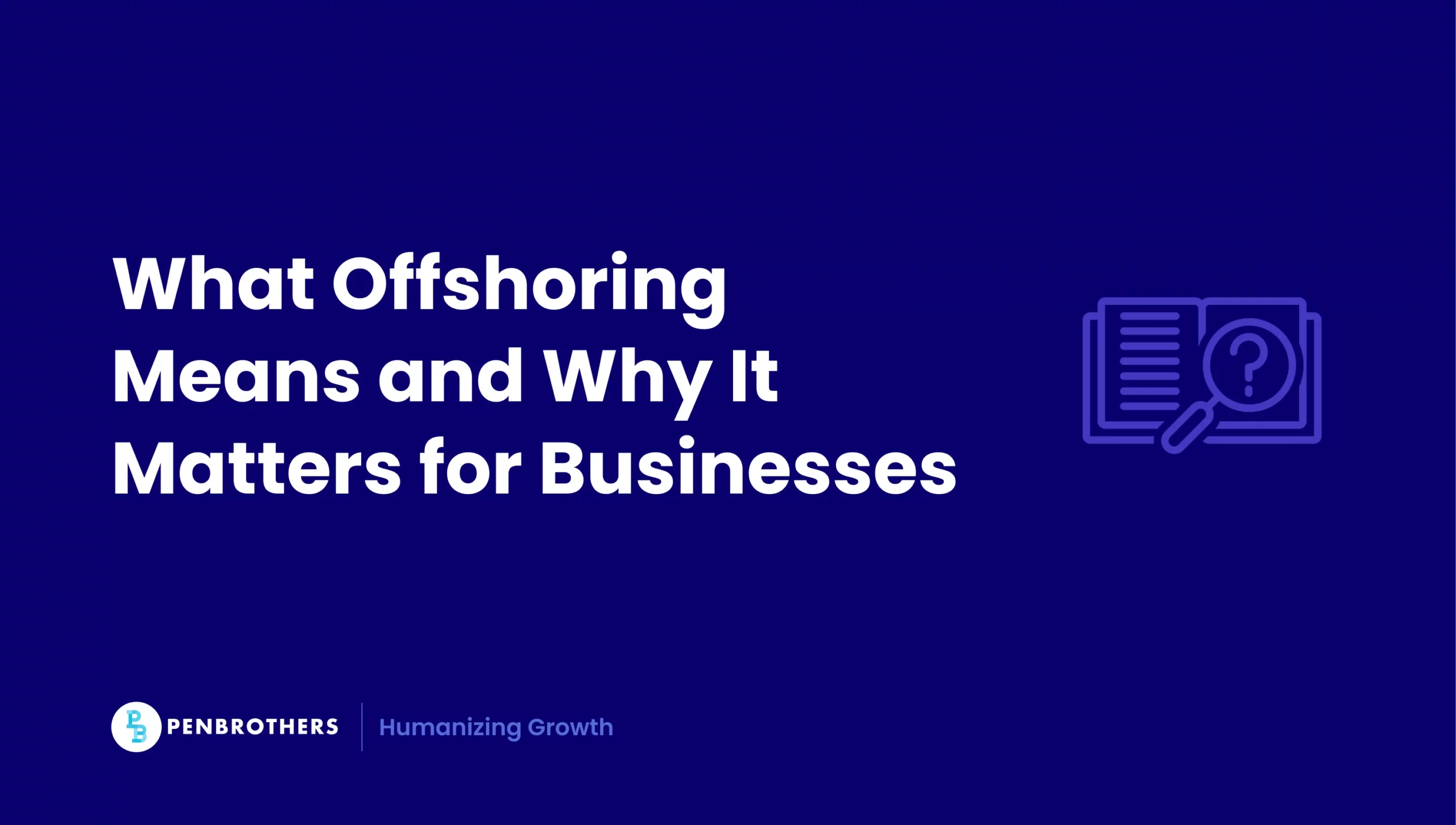What's Inside?
What Is Offshoring? Definition, Meaning, and Key Examples

Six months ago, you tried hiring a remote developer from Eastern Europe. The interviews went well. His portfolio looked solid. But from day one, everything went sideways. Communication was terrible. Deadlines slipped. Code quality declined. After three painful months, you cut ties and went back to local hiring.
Then, you blamed the entire offshoring model when the real problem was execution.
The thing is, companies succeeding with offshore teams aren’t lucky. They’ve figured out what most businesses miss: offshoring doesn’t merely mean finding cheaper talent. When done strategically, it means building global capability that compounds your competitive advantage.
Offshoring definition: the relocation of a business process, operation, or function to another country, typically for cost savings, access to talent, or efficiency gains.
But here’s what most definitions miss: when done right, offshoring reshapes how companies compete globally.
This article breaks down what offshoring really means in today’s business, why fast-growing companies choose it, and where smart leaders are heading next.
Key Takeaways
- A Strategic Tool for Building Capability: The meaning of offshoring has evolved beyond simple cost-cutting. It is now a strategic approach for accessing specialized global talent, scaling operations quickly, and building a 24/7 operational cycle to gain a competitive advantage.
- Offshoring and Outsourcing Are Not the Same: This is a critical distinction. Offshoring refers to the location of a business function (moving it to another country). Outsourcing refers to who performs the function (a third-party vendor). A company can offshore work without outsourcing it by setting up its own foreign office.
- A Wide Spectrum of Services Can Be Offshored: Offshoring is not limited to one type of work. It ranges from production offshoring (manufacturing) and IT-enabled services (customer support) to high-value Knowledge Process Offshoring (KPO), which includes complex tasks like R&D, engineering, and financial analysis.
- The Future is About Resilience and Higher-Value Work: The future of offshoring is being shaped by AI and automation, which will shift the focus toward more complex services. Geopolitical considerations are also driving new trends like nearshoring and “friendshoring” to build more resilient global operations.
Offshoring Definition: What It Really Means
At its core, offshoring is simple: moving part of your business to another country. That might mean relocating manufacturing lines, setting up a development hub, or building a customer support center overseas.
The driver varies. Might be to lower labor costs, access to specialized skills, proximity to resources, or strategic market positioning.
But here’s where people get confused (including me when I first got into this business): offshoring isn’t the same as outsourcing. Outsourcing means contracting work to a third-party vendor, which can happen locally or abroad. Offshoring can involve outsourcing (like hiring a call center in the Philippines) or keeping operations in-house (like building your own delivery center in India). These terms overlap, but they’re not interchangeable.
The distinction matters because it shapes how you approach the strategy.
Offshoring’s Meaning in Today’s Business Context
The meaning of offshoring has evolved dramatically. Initially, it was pure labor arbitrage: moving jobs to countries with cheaper wages. Today, it has gotten more sophisticated (and competitive). Companies offshore not just to save money, but to:
- Access specialized skills in engineering, IT, and data science that are scarce locally
- Scale operations faster by tapping global labor markets
- Shorten time-to-market by running parallel teams across time zones
- Establish strategic presence in emerging economies
A Deloitte report confirms this shift: cost savings remain important, but innovation, scalability, and agility now drive offshoring decisions.
So, the companies getting this right aren’t merely cutting costs, they’re building competitive advantages that compound over time.
Why Companies Choose Offshoring
1. The Labor Cost Reality
Yes, wages differ drastically across regions. A software engineer in Silicon Valley costs five to six times more than an equally skilled developer in Bangalore. But smart companies don’t stop at the salary comparison. They calculate the total value equation.
Offshoring allows businesses to reinvest savings into R&D, marketing, or scaling. The key is viewing cost savings as fuel for growth, not just margin improvement.
2. Access to Specialized Talent
Countries like India, the Philippines, and Poland have developed deep pools of IT and engineering talent. When you can’t find the skills locally, or when local talent is prohibitively expensive, offshoring opens up possibilities.
A World Bank study highlights how offshoring drives skill development and global knowledge exchange. The talent pipeline keeps growing because these countries invest heavily in education and technical training.
3. The 24/7 Advantage
With operations running across different time zones, companies effectively operate around the clock. A design team in London hands off to developers in Manila, who pass deliverables back by morning, which significantly impacts speed to market.
When your competitors are still thinking locally, you’re already operating globally.
4. Geographic Strategy
Automakers move production closer to raw materials. Retailers build offshore hubs closer to growth markets. Sometimes the real advantage is proximity, not price.
5. Cognitive Diversity
Different perspectives spark creativity. Multicultural teams often approach problems in ways that lead to breakthrough solutions.
Common Types of Offshoring
- Production Offshoring: Relocating physical manufacturing. Example: NAFTA enabled U.S. manufacturers to move plants to Mexico. Later, many shifted to China for scale and cost efficiency.
- IT-enabled Services Offshoring: Call centers, software development, data entry. The Philippines and India dominate here due to English proficiency and large talent pools.
- Knowledge Process Offshoring (KPO): Higher-value services like R&D, analytics, and engineering. These require specialized expertise and stronger IP protections.
- Business Process Offshoring (BPO): HR, payroll, recruitment, and finance functions. Many global companies offshore these to streamline back-office operations.
Each type requires different management approaches and risk considerations.
Key Examples of Offshoring in Practice
- Tech Giants: Microsoft and Google have established offshore development centers in India to leverage talent at scale while maintaining quality standards.
- Manufacturing Brands: Apparel companies like Nike offshore production to Vietnam and Indonesia, balancing cost efficiency with quality control.
- Service Industries: American Express and other financial firms have offshored call centers and back-office work to the Philippines, creating dedicated teams that understand their business.
Each example shows the blend of cost advantage and strategic capability building. The companies succeeding long-term aren’t just moving work overseas. They’re building integrated global operations.
Pros and Cons of Offshoring
Advantages
- Cost savings free capital for innovation and growth initiatives
- Talent access helps companies tackle skill shortages and specialized needs
- Operational efficiency from global operations creates faster turnaround and continuous productivity
- Economic impact in destination countries includes job creation and infrastructure development
Disadvantages
- Job displacement in home countries can trigger political and social backlash
- Communication challenges arise from time zones, cultural differences, and language barriers
- IP and data security risks increase when sensitive work crosses borders
- Regulatory complexity differs by country and can complicate compliance efforts
While benefits are real, execution challenges make or break offshore strategies. Success depends on how well you manage the transition and ongoing operations.
Offshoring vs. Nearshoring vs. Reshoring
- Offshoring: Moving operations abroad, often to distant countries, for maximum cost advantage
- Nearshoring: Choosing closer countries (e.g., U.S. companies nearshore to Mexico) to reduce cultural and time zone gaps while maintaining cost benefits
- Reshoring: Bringing operations back home, often driven by automation advances, political considerations, or rising offshore costs
The COVID-19 pandemic revealed supply chain fragility and changed the equation. Companies now weigh resilience as heavily as cost. Some research highlights “friendshoring” strategies (moving work to politically aligned nations) as a rising trend.
The choice between these approaches depends on your specific industry, risk tolerance, and strategic objectives.
The Future of Offshoring
Offshoring has been evolving rapidly in the past few years, and these three forces are reshaping its future:
- Automation and AI: Routine tasks once offshored may be automated entirely, shifting focus toward higher-value services. By 2030, activities that account for up to 30 percent of hours currently worked across the US economy could be automated, a trend accelerated by generative AI.
- Supply Chain Resilience: Companies are diversifying locations to avoid overreliance on single countries. “China +1” strategies (China plus Vietnam or India) are becoming standard practice.
- Ethics and Sustainability: From labor standards to environmental impact, stakeholders increasingly expect responsible global operations. This adds complexity but also competitive differentiation.
The future belongs to companies that view offshoring as capability building, not just cost-cutting.
For smart and fast-growing companies, the question isn’t whether to offshore. It’s how to do it strategically, responsibly, and with long-term vision. The businesses that figure this out will consistently outpace those still struggling to do everything in-house.
Remember that failed developer from six months ago? The difference between that experience and success often comes down to one thing: having the right partner who understands both the strategic vision and execution details.
Companies that get offshoring right don’t just find cheaper talent; they build sustainable competitive advantages.
Frequently Asked Questions
Offshoring is about location—it means relocating a business process to another country. Outsourcing is about who does the work—it means contracting that process to a third-party company. You can offshore work by outsourcing it to a foreign firm, or you can offshore by setting up your own company-owned center in another country.
Beyond significant cost savings, companies offshore to:
• Access specialized talent, like engineers and data scientists, that is scarce or prohibitively expensive in their home country.
• Scale operations much more quickly than domestic hiring allows.
• Achieve a 24/7 operational cycle by using teams across different time zones, which accelerates project delivery.
• Establish a strategic presence in emerging markets.
The most common types are:
• Production Offshoring: Relocating physical manufacturing plants.
• IT-enabled Services Offshoring: Functions like software development, data entry, and call centers.
• Knowledge Process Offshoring (KPO): Higher-value, analytical work like research and development, engineering, and financial analysis.
• Business Process Offshoring (BPO): Back-office functions such as HR, payroll, and finance.
Offshoring: Moving operations to a distant country, often for maximum cost advantage.
Nearshoring: Moving operations to a nearby country to minimize time zone and cultural differences (e.g., a US company moving work to Mexico).
Reshoring: Bringing previously offshored operations back to the home country.
The main risks include potential job displacement in the home country, communication challenges arising from different cultures and time zones, increased intellectual property and data security risks, and the complexity of navigating a foreign country’s legal and regulatory environment.




